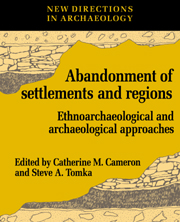Book contents
- Frontmatter
- Contents
- List of figures
- List of tables
- List of contributors
- Acknowledgments
- PART I INTRODUCTION
- PART II REGIONAL ABANDONMENT PROCESSES: ETHNOARCHAEOLOGICAL CASES
- 2 Site abandonment behavior among transhumant agro-pastoralists: the effects of delayed curation on assemblage composition
- 3 Settlement organization and residential variability among the Rarámuri
- 4 Occupational and locational instability in arid land settlement
- 5 Models of abandonment and material culture frequencies
- 6 Agricultural abandonment: a comparative study in historical ecology
- PART III REGIONAL ABANDONMENT PROCESSES: ARCHAEOLOGICAL CASES
- PART IV ABANDONMENT PROCESSES WITHIN SITES: ETHNOARCHAEOLOGICAL CASES
- PART V ABANDONMENT PROCESSES WITHIN SITES: ARCHAEOLOGICAL CASES
- PART VI CONCLUSIONS
- Index
2 - Site abandonment behavior among transhumant agro-pastoralists: the effects of delayed curation on assemblage composition
Published online by Cambridge University Press: 23 May 2010
- Frontmatter
- Contents
- List of figures
- List of tables
- List of contributors
- Acknowledgments
- PART I INTRODUCTION
- PART II REGIONAL ABANDONMENT PROCESSES: ETHNOARCHAEOLOGICAL CASES
- 2 Site abandonment behavior among transhumant agro-pastoralists: the effects of delayed curation on assemblage composition
- 3 Settlement organization and residential variability among the Rarámuri
- 4 Occupational and locational instability in arid land settlement
- 5 Models of abandonment and material culture frequencies
- 6 Agricultural abandonment: a comparative study in historical ecology
- PART III REGIONAL ABANDONMENT PROCESSES: ARCHAEOLOGICAL CASES
- PART IV ABANDONMENT PROCESSES WITHIN SITES: ETHNOARCHAEOLOGICAL CASES
- PART V ABANDONMENT PROCESSES WITHIN SITES: ARCHAEOLOGICAL CASES
- PART VI CONCLUSIONS
- Index
Summary
Introduction
In recent years studies by Binford (1979), Shott (1986, 1989), Torrence (1983, 1987), Bleed (1986), and others have significantly contributed to the understanding of the relationships between land–use patterns, technological organization, and assemblage composition. These studies focus primarily on the conditioning effects of subsistence organization. The effects of abandonment processes upon assemblage composition have received relatively less attention. In general, assemblage structure and content are seen as conditioned by artifact use life (Schiffer 1975; Shott 1989), various discard behaviors (Deal 1985; Schiffer 1987), and curation at the time of site abandonment (Binford 1973; Schiffer 1987). Abandonment studies have alerted us to another series of processes that condition the composition of archaeological assemblages (Joyce and Johannessen 1987; Lange and Rydberg 1972; Schiffer 1987; Stevenson 1982). Stevenson, working at nineteenth–century gold rush mining camps, was the first to consider systematically the effects of abandonment conditions on the proportion of curated and discarded artifacts. Based on the composition of abandoned assemblages and the presence of abandonment caches, Stevenson also suggested, among other things, that the anticipation of return may significantly affect abandonment behavior.
The gold rush camps distributed along Bullion Creek were abandoned relatively suddenly and in an unplanned manner because of flooding, poor working conditions, and the discovery of a rich strike some distance from Bullion Creek. The camps located on Mush Creek were abandoned under more normal conditions, and without anticipation of return (Stevenson 1982:238–40).
- Type
- Chapter
- Information
- The Abandonment of Settlements and RegionsEthnoarchaeological and Archaeological Approaches, pp. 11 - 24Publisher: Cambridge University PressPrint publication year: 1993
- 14
- Cited by



